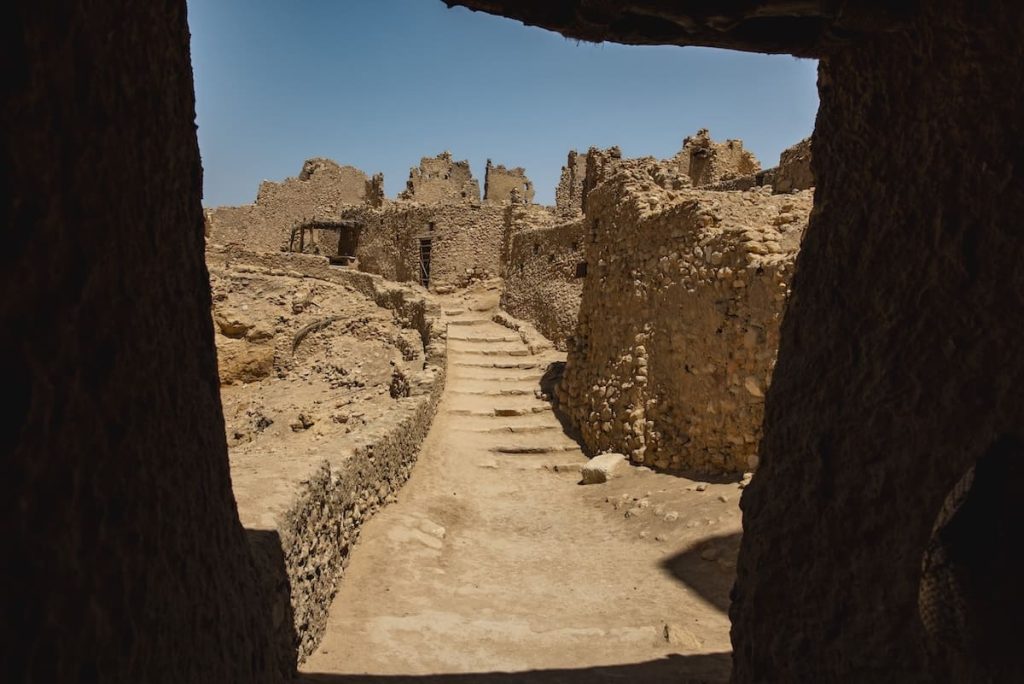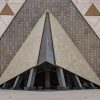Introduction To Siwa’s Historical Landmarks
Imagine a place where time seems to stand still, where the golden sands of the desert meet lush, verdant oases, and where ancient whispers echo through the wind. Welcome to Siwa Oasis, a hidden gem in the heart of Egypt’s Western Desert. Picture yourself wandering through serene landscapes, discovering historical landmarks that tell tales of a bygone era. Siwa’s rich cultural heritage and historical significance are etched into every corner of this mystical place, offering a journey through time that captivates the soul.
In this article, we’ll embark on an exploration of Siwa’s historical landmarks, delving into their significance and uncovering the stories they hold. From the revered Temple of the Oracle of Amun to the enigmatic Mountain of the Dead, each site offers a unique glimpse into the oasis’s vibrant past. Join me as we uncover the secrets of Siwa, a timeless adventure waiting to be discovered.

History of Siwa
Siwa Oasis has a long and storied history that stretches back thousands of years. It is believed to have been inhabited since prehistoric times, with evidence of human settlement dating back to at least the 10th millennium BCE. The oasis has always been a vital stop on trade routes, linking Egypt with the rest of North Africa and beyond. Explore more of this fascinating history with our Great Pharaohs and White Desert Tour.
During the Pharaonic period, Siwa gained prominence due to its association with the god Amun. The oasis was home to the famous Oracle of Amun, located in the Temple of the Oracle of Amun (Temple of Aghurmi). The oracle’s prophecies were highly sought after by pharaohs and other rulers, most notably Alexander the Great, who visited Siwa in 332 BCE to seek confirmation of his divine status.
In addition to its religious significance, Siwa played a crucial role in the political and military strategies of ancient Egypt. The oasis’s remote location and natural defenses made it an ideal place for fortifications and refuges. Over the centuries, Siwa remained an important center of culture and commerce, even as it experienced periods of isolation and integration with the broader Egyptian state.
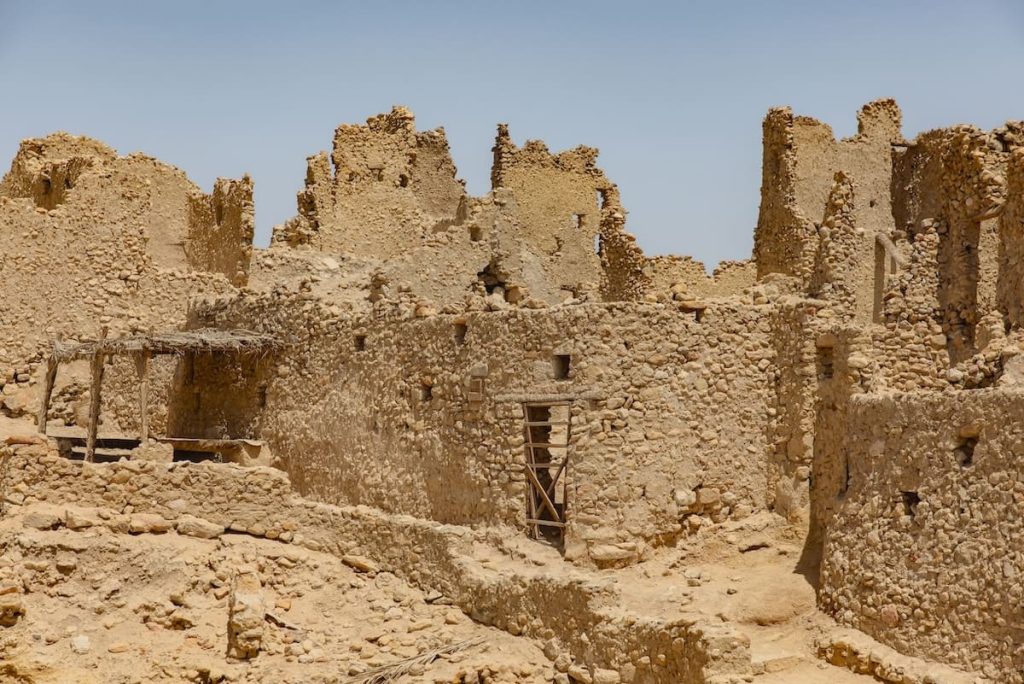
The Greco-Roman period saw Siwa continue to thrive as a center of worship and trade. The influence of Greek and Roman culture is evident in the architectural and artistic elements found in Siwa’s ancient sites. Despite its relative isolation, Siwa maintained connections with the Mediterranean world, blending local traditions with foreign influences.
Islamic conquest in the 7th century brought significant changes to Siwa, as it did to the rest of Egypt. The oasis adapted to the new cultural and religious landscape, incorporating Islamic practices into its daily life while preserving many of its ancient customs. The construction of Shali Fortress in the 13th century exemplifies this blend of old and new, as the fortress served both as a defensive stronghold and a symbol of Siwan identity.
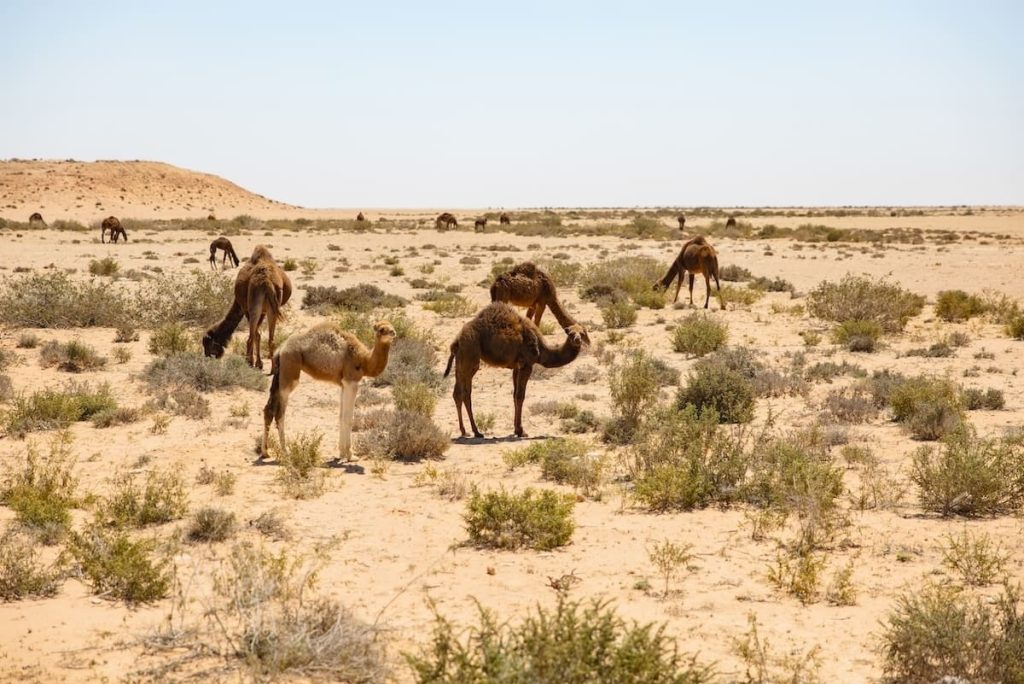
Throughout the medieval and early modern periods, Siwa remained a somewhat isolated and self-sufficient community. Its unique blend of Berber, Egyptian, and later Arab influences created a distinct cultural identity that has endured to this day. The oasis’s isolation helped preserve its traditions and way of life, even as the world around it changed.
In recent years, Siwa has gained recognition for its cultural and historical significance, attracting visitors from around the world. Efforts to preserve and promote Siwa’s heritage have brought renewed attention to its ancient landmarks and traditional practices. Today, Siwa stands as a testament to the resilience and adaptability of its people, offering a rich tapestry of history, culture, and natural beauty for all who visit
Nestled amidst the tranquil sands of Siwa, the Temple of the Oracle of Amun stands as a testament to the oasis’s ancient grandeur. Imagine walking through this hallowed site, where pharaohs once sought divine guidance and Alexander the Great journeyed to seek his destiny. Discover the mysteries of this sacred site on our Siwa Oasis Adventure Tour.
The Temple of the Oracle of Amun, also known as the Temple of Aghurmi, holds a significant place in both Egyptian and Greco-Roman history. Dating back to the 26th Dynasty (664-525 BC), it was a revered center of worship dedicated to the god Amun. The oracle, renowned for its prophetic powers, played a crucial role in the political and spiritual realms of ancient Egypt.
Architecturally, the temple is a marvel. Built on a limestone plateau, its ruins reveal a complex structure of chambers and courtyards, adorned with inscriptions and reliefs that depict scenes of devotion and ritual. The temple’s unique design, combining Egyptian and Greek influences, reflects Siwa’s position as a cultural crossroads.
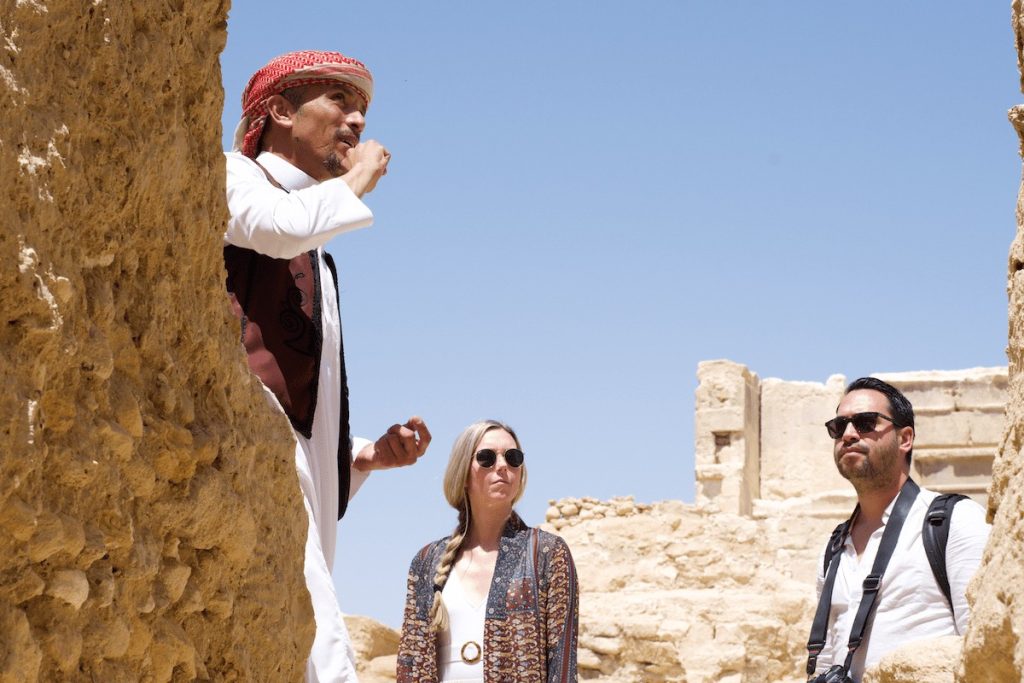
One of the most intriguing aspects of the Temple of the Oracle of Amun is its role in the life of Alexander the Great. In 332 BC, Alexander traveled to Siwa to consult the oracle, seeking affirmation of his divine ancestry and legitimacy as a ruler. Legend has it that the oracle confirmed his status as the son of Zeus-Amun, cementing his authority and shaping his destiny.
As you wander through the remnants of this ancient temple, you can almost hear the whispers of the past, feel the weight of history, and sense the spiritual significance that once permeated this sacred site. The Temple of the Oracle of Amun is not just a historical landmark; it’s a gateway to understanding the rich tapestry of Siwa’s heritage.
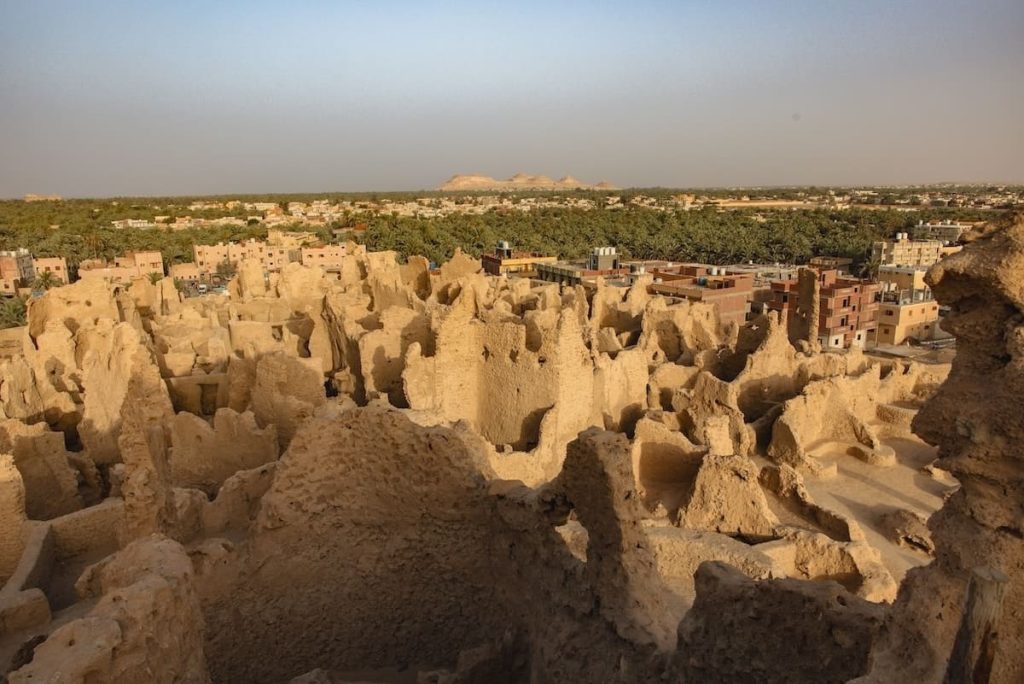
Shali Fortress
Standing proudly in the heart of Siwa Oasis, Shali Fortress is a symbol of resilience and community. Imagine exploring this ancient citadel, with its towering mud-brick walls and labyrinthine streets, where the echoes of Siwan life reverberate through the ages. Experience the rich heritage of Shali Fortress on our Exploring Coptic Cairo Tour.
Built in the 13th century, Shali Fortress was constructed from kershef, a traditional Siwan building material made from salt and mud. This formidable stronghold served as both a defensive structure and a hub of daily life for the Siwan people. Its architectural style, with thick walls and narrow passageways, was designed to protect against invaders and withstand the harsh desert climate.
Throughout its history, Shali Fortress has witnessed numerous significant events. It played a crucial role in defending Siwa from external threats and provided refuge for the oasis’s inhabitants during times of conflict. The fortress’s strategic location atop a hill offered a commanding view of the surrounding landscape, ensuring early detection of approaching danger.
Today, Shali Fortress stands as a poignant reminder of Siwa’s storied past. Efforts are underway to preserve and restore this historical landmark, ensuring that future generations can appreciate its architectural and cultural significance. Walking through its ruins, you can feel the spirit of Siwa’s ancestors and gain a deeper understanding of the community’s enduring strength and resilience.
Shali Fortress is more than just a historical site; it’s a living testament to the ingenuity and tenacity of the Siwan people. As you explore its ancient walls and winding alleys, you’ll uncover the stories of those who called this fortress home, experiencing firsthand the rich history and vibrant culture that define Siwa Oasis.
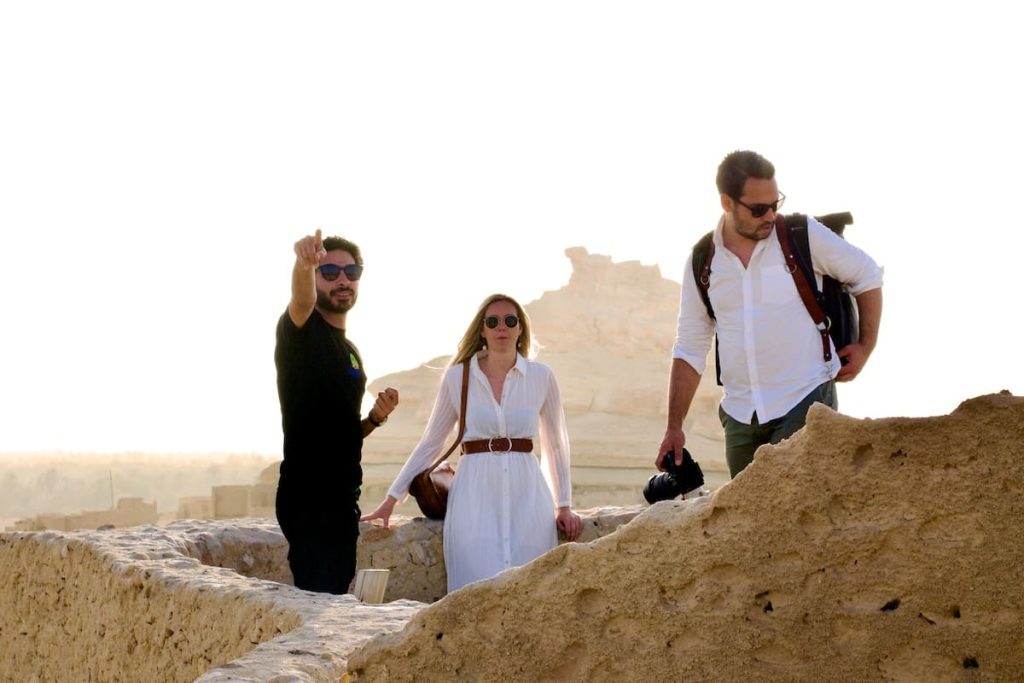
Mountain of the Dead (Gebel al-Mawta)
Imagine standing atop a hill where the desert breeze carries the silent tales of ancient souls, surrounded by a panorama of Siwa’s serene beauty. This is the Mountain of the Dead, or Gebel al-Mawta, an ancient necropolis that offers a hauntingly beautiful glimpse into the burial practices of a civilization long past. Visit this intriguing site on our Ancient Egypt and the Red Sea Tour.
The Mountain of the Dead is a sprawling burial site, used from the 26th Dynasty through to the Roman period. Its arid slopes are dotted with tombs carved into the limestone, each one a testament to the reverence for the afterlife held by the ancient Siwans. These tombs, with their intricate carvings and frescoes, provide invaluable insights into the beliefs and customs of the time.
As you explore the necropolis, you’ll encounter some of the most significant tombs, each with its own story to tell. The Tomb of Si-Amun is one of the most elaborate, featuring vibrant wall paintings that depict scenes of daily life and religious rituals. The Tomb of Mesu-Isis is another highlight, showcasing beautifully preserved reliefs that offer a window into the past.
The burial practices observed at the Mountain of the Dead reflect a complex blend of Egyptian and local influences. The tombs’ designs and the artifacts found within them reveal a culture that deeply valued the journey to the afterlife, ensuring that the deceased were well-prepared for eternity. These practices were not just about honoring the dead, but also about maintaining a connection with the divine and the natural world.

Legends and myths abound in this ancient necropolis. One such legend speaks of the tombs being inhabited by spirits who protect the sacred site. Visitors often speak of a palpable sense of history, as if the very stones are whispering the secrets of those who rest here.
The Mountain of the Dead is not just a burial site; it’s a place where history and myth intertwine, offering a unique perspective on Siwa’s ancient past. As you walk among the tombs, you’ll feel a profound connection to the people who once lived in this oasis, gaining a deeper appreciation for their culture and their enduring legacy.
In this timeless place, the Mountain of the Dead stands as a silent guardian of Siwa’s history, inviting you to explore its mysteries and discover the stories that have shaped this remarkable oasis.
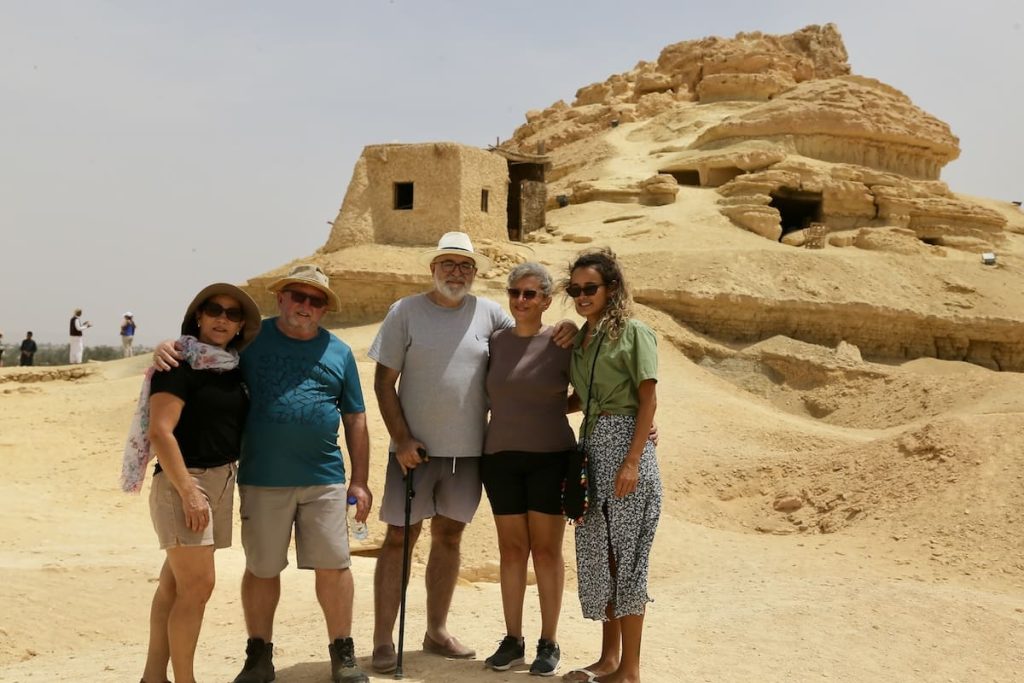
Cleopatra's Spring (Ain al-Hammam)
For centuries, Cleopatra’s Spring has been a focal point of Siwan daily life. Locals come here to collect water, wash their clothes, and socialize. It’s a place where the community gathers, sharing stories and traditions, and maintaining a connection to their cultural heritage. For visitors, a dip in the spring is a must-do experience, offering a refreshing break and a unique way to connect with the local culture.
The myths and stories surrounding Cleopatra’s Spring add to its allure. Some say that the waters have healing properties, while others believe that bathing in the spring can bestow beauty and vitality. These tales, whether based in fact or fiction, contribute to the spring’s mystique and charm.
Cleopatra’s Spring is more than just a natural attraction; it’s a living piece of Siwan heritage. As you immerse yourself in its cool, clear waters, you’ll feel a connection to the generations who have come before, experiencing a piece of history that continues to flow through this remarkable oasis. Whether you’re seeking relaxation, rejuvenation, or simply a moment of tranquility, Cleopatra’s Spring offers an unforgettable experience that captures the essence of Siwa Oasis.
Temple of Umm Ubayd (Temple of Umm Ubayda)
Imagine wandering through the serene Siwan landscape and stumbling upon the remnants of an ancient temple, its stones whispering tales of devotion and reverence. This is the Temple of Umm Ubayd, a site that offers a profound connection to the spiritual and historical tapestry of Siwa Oasis. Explore this temple on our Great Pharaohs and White Desert Tour.
The Temple of Umm Ubayd, also known as the Temple of Umm Ubayda, dates back to the 26th Dynasty of ancient Egypt. It was dedicated to the god Amun, a testament to the widespread worship of this deity across Egypt, even in remote oases like Siwa. This temple is believed to have played a significant role in the religious life of the Siwan people, serving as a center for worship and community gatherings.
The history of the Temple of Umm Ubayd is deeply intertwined with that of the Oracle of Amun, located nearby at the Temple of the Oracle of Amun (Temple of Aghurmi). The proximity of these two sites suggests a shared spiritual significance, with pilgrims likely visiting both to seek guidance and pay homage to the god Amun.
Architecturally, the Temple of Umm Ubayd is a fascinating site. Though much of it lies in ruins, the surviving elements hint at its former grandeur. Intricate carvings and inscriptions adorn the temple walls, offering glimpses into the religious practices and artistic achievements of the time. These inscriptions are invaluable for historians and archaeologists, providing insights into the cultural and religious landscape of ancient Siwa.
One of the most intriguing features of the Temple of Umm Ubayd is its alignment with celestial events. The temple was designed to align with the solstices, reflecting the ancient Egyptians’ deep understanding of astronomy and its integration into their religious practices. This alignment would have imbued the temple with a sense of cosmic significance, linking the earthly realm with the divine.
Today, the Temple of Umm Ubayd stands as a poignant reminder of Siwa’s rich historical and spiritual heritage. Efforts to preserve and protect this site are ongoing, ensuring that future generations can appreciate its significance. As you explore the temple’s ruins, you can’t help but feel a sense of awe and wonder, imagining the devotion and reverence that once filled this sacred space.
The Temple of Umm Ubayd is not just a historical landmark; it’s a bridge to the past, offering a window into the spiritual life of ancient Siwa. As you walk among its stones, you’ll gain a deeper appreciation for the oasis’s rich history and the enduring legacy of those who once worshipped here.
Fatnas Island (Fantasy Island)
Picture an island oasis where time seems to slow down, and the stresses of modern life melt away. Welcome to Fatnas Island, also known as Fantasy Island, a serene and picturesque haven on the edge of Siwa Oasis. Relax in this tranquil paradise on our Ancient Egypt and the Red Sea Tour.
Fatnas Island is situated on the salt lake of Birket Siwa, surrounded by swaying palm trees and crystal-clear waters. This idyllic setting makes it a perfect spot for relaxation and reflection. Imagine lounging under the shade of a palm tree, with the gentle sound of water lapping against the shore and the soft rustle of leaves in the breeze.
Historically, Fatnas Island has been a significant part of Siwan culture and daily life. The island’s lush greenery and abundant water sources have made it a vital resource for the local community, providing both sustenance and a place for social gatherings. The island’s natural beauty has also inspired countless stories and legends, adding to its allure.
One of the key attractions of Fatnas Island is its hot spring, which offers a soothing and rejuvenating experience for visitors. The warm, mineral-rich waters are believed to have therapeutic properties, making it a popular spot for both locals and tourists. Whether you’re seeking relief from the desert heat or simply want to unwind, a dip in the spring is a must-do activity.
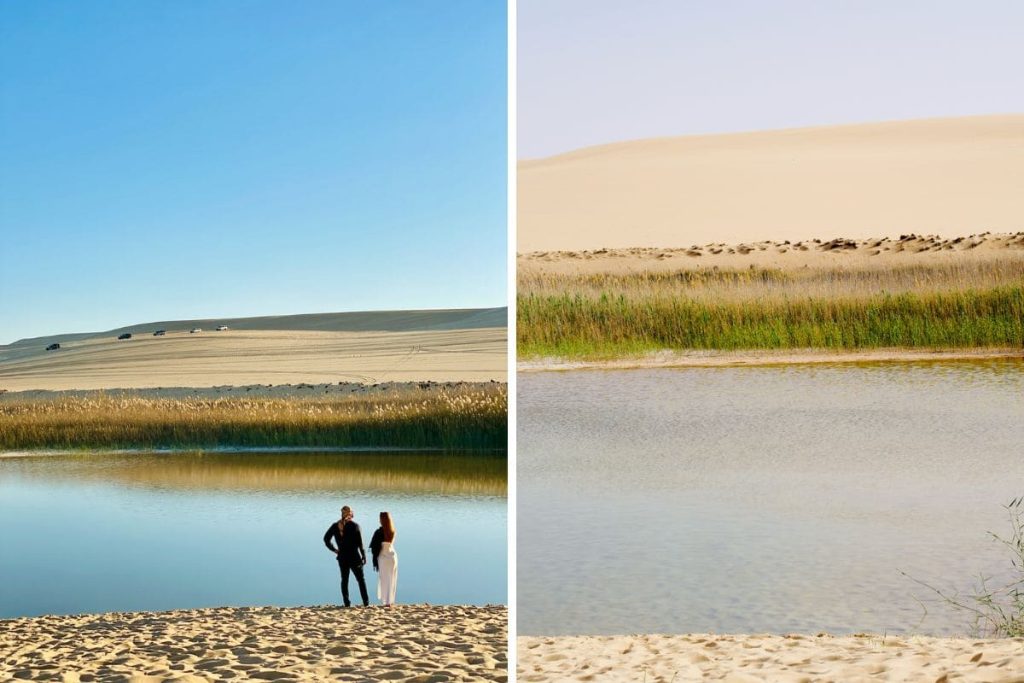
The island’s role in Siwan culture extends beyond its natural resources. It has long been a place for relaxation and recreation, where locals come to enjoy picnics, swim, and escape the demands of everyday life. For visitors, Fatnas Island offers a unique opportunity to experience this aspect of Siwan culture firsthand.
As you explore Fatnas Island, you’ll discover not just its natural beauty, but also the deep connection the Siwan people have with their environment. The island’s palm groves and tranquil waters provide a perfect backdrop for reflection and appreciation of the oasis’s rich heritage.
Fatnas Island, with its stunning landscapes and cultural significance, is a true gem of Siwa Oasis. Whether you’re seeking adventure, relaxation, or a deeper understanding of Siwan life, this enchanting island offers an unforgettable experience that captures the essence of Siwa’s timeless charm. As you relax on the island, you’ll feel a sense of peace and wonder, knowing that you’re partaking in a tradition that has been cherished for generations.
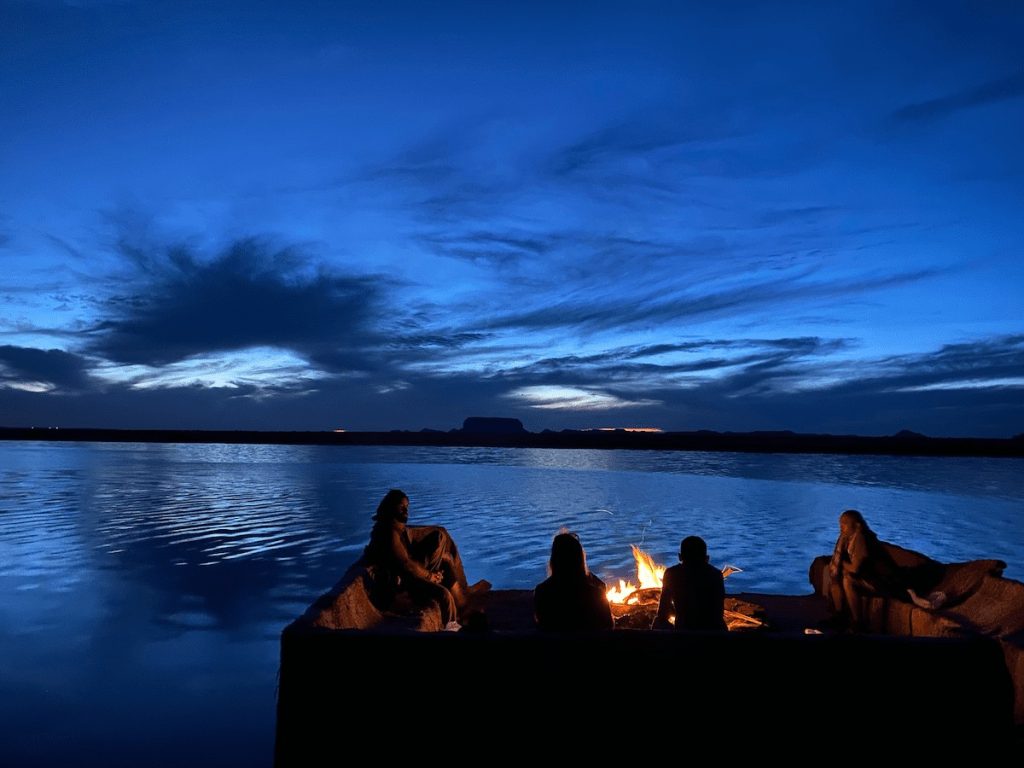
Juba’s Spring (Ain Qurayshat)
Imagine a hidden spring nestled within the vast expanse of the desert, a place where history, myth, and nature converge. This is Juba’s Spring, also known as Ain Qurayshat, a serene and storied oasis within Siwa that beckons with its crystal-clear waters and ancient lore. Visit this spring on our Private Tour – Valley of Kings & Temples Day Tour
Juba’s Spring holds a special place in the heart of Siwa’s history and culture. Named after the ancient Libyan King Juba II, the spring is a symbol of the enduring relationship between Siwa and the broader region. According to legend, King Juba II discovered this spring during his travels, and it became a treasured source of water in the arid landscape of the desert. This connection to a historical figure adds a layer of depth and intrigue to the spring, making it a place where history feels palpably close.
The spring itself is a marvel of nature. The clear, cool waters emerge from the earth, providing a refreshing contrast to the surrounding desert. Surrounded by lush vegetation, the spring is an inviting spot for visitors looking to cool off and enjoy the tranquil beauty of Siwa. The water is so pure and inviting that it’s almost impossible to resist the urge to take a dip and feel the rejuvenating effects of this natural wonder.
Juba’s Spring is not just a place of beauty but also a vital part of Siwan daily life. For centuries, it has served as a crucial water source for the local community, supporting both agriculture and daily living. The spring’s waters are used to irrigate the nearby fields of date palms and other crops, sustaining the oasis’s agricultural heritage. The presence of this life-giving water in such an arid environment is a testament to the resilience and resourcefulness of the Siwan people.
Cultural traditions and stories abound around Juba’s Spring. It is said that the spring possesses healing properties, and many locals and visitors believe that drinking or bathing in its waters can bring health and vitality. These beliefs have been passed down through generations, creating a rich tapestry of myths and legends that enhance the spring’s mystique.
As you sit by the edge of Juba’s Spring, listening to the gentle flow of water and the rustling of leaves, you can’t help but feel a profound connection to the past. This spring is more than just a source of water; it is a living piece of Siwan heritage, a place where the ancient and the modern coexist in perfect harmony. Visiting Juba’s Spring offers a unique opportunity to experience the timeless beauty and cultural richness of Siwa Oasis, providing a serene escape into nature and history.
The Great Sand Sea
Imagine standing at the edge of an endless expanse of rolling dunes, the golden sands stretching as far as the eye can see, shimmering under the brilliant desert sun. This is the Great Sand Sea, one of the most striking natural wonders of Siwa Oasis, and a vast desert landscape that captivates with its raw beauty and sense of limitless adventure. Explore the vastness of this desert on our Desert Adventure Tours.
The Great Sand Sea is not just a desert; it is a vast and awe-inspiring expanse of sand dunes, some of which reach heights of up to 140 meters. These dunes, constantly shaped and reshaped by the winds, create a dynamic and ever-changing landscape that is both beautiful and daunting. The sheer scale of the Great Sand Sea is humbling, offering a sense of solitude and freedom that is hard to find anywhere else.
Geographically, the Great Sand Sea spans approximately 72,000 square kilometers, making it one of the largest sand deserts in the world. Its vastness is a defining feature of the Siwa region, influencing both the climate and the culture of the oasis. The desert’s harsh conditions have shaped the way of life in Siwa, fostering a deep respect for nature and an understanding of how to live sustainably in such an extreme environment.
Historically, the Great Sand Sea has played a significant role in the lives of those who call Siwa home. For centuries, it has been a barrier and a protector, isolating the oasis from the rest of Egypt and allowing Siwa to develop its unique culture and traditions. The desert has also been a source of inspiration and legend, with countless stories of explorers and adventurers who have braved its vastness.
One of the most famous expeditions to the Great Sand Sea was led by the explorer László Almásy, who traversed the desert in the 1930s. His adventures in this uncharted territory were later immortalized in the book and film “The English Patient.” Almásy’s journeys highlight the desert’s allure and the sense of mystery and discovery that it inspires.
Today, the Great Sand Sea offers a wealth of opportunities for modern-day adventurers. From sandboarding down the towering dunes to embarking on 4×4 desert safaris, visitors can experience the thrill of exploring this vast wilderness. The desert also provides a unique backdrop for stargazing, where the lack of light pollution allows for breathtaking views of the night sky, with countless stars illuminating the heavens above.
The Great Sand Sea is not just a geographical feature; it is an integral part of Siwa’s identity and a testament to the enduring allure of the desert. As you venture into this vast expanse of sand, you’ll experience a sense of wonder and awe, connecting with the timeless beauty of nature and the spirit of adventure that has drawn people to Siwa for generations. The Great Sand Sea is a place where you can lose yourself in the majesty of the desert and find a deeper appreciation for the resilience and beauty of the natural world.
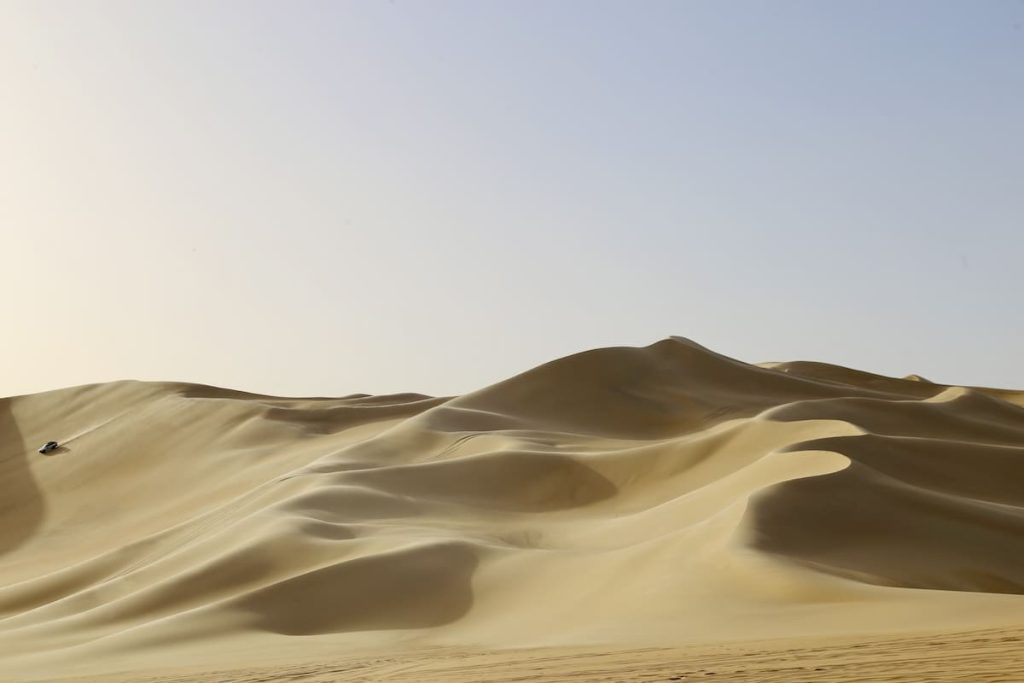
Dakrour Mountain
Imagine climbing a mountain where every step takes you closer to the heavens and every turn reveals a new piece of history. Welcome to Dakrour Mountain, a site of immense cultural and historical significance in Siwa Oasis. Experience the therapeutic warmth of the sands on our Great Pharaohs and White Desert Tour.
Dakrour Mountain, located a few kilometers from the center of Siwa, has been a focal point of local culture for centuries. The mountain is best known for its therapeutic hot sands, which are believed to have healing properties. Every summer, people from Siwa and beyond come to Dakrour Mountain to participate in traditional sand baths, where they are buried up to their necks in the hot sand. This practice is said to alleviate a variety of ailments, from rheumatism to arthritis, and has been passed down through generations.
Historically, Dakrour Mountain has also been a place of spiritual significance. It is home to the ruins of ancient temples and tombs, dating back to the Pharaonic and Greco-Roman periods. These ancient structures, though weathered by time, still stand as a testament to the mountain’s long-standing importance as a site of worship and ritual. The most notable of these ruins is the Temple of Amun, which is believed to have been a center for oracles and religious ceremonies.
The mountain’s strategic location also made it a key defensive position in ancient times. From its summit, you can see panoramic views of the surrounding oasis and the vast desert beyond, making it an ideal lookout point. This vantage point was crucial for the ancient Siwans, who needed to protect their oasis from potential invaders.
Today, Dakrour Mountain continues to be a site of cultural and recreational significance. The annual festival of Eid al-Siyaha, or the “Tourism Festival,” is held here each October. During this festival, the Siwan people come together to celebrate their heritage with music, dance, and traditional food. The festival is a vibrant display of Siwan culture and a testament to the community’s enduring connection to Dakrour Mountain.
Visiting Dakrour Mountain is more than just a hike; it’s a journey through time and tradition. As you climb its slopes, you’ll encounter the remnants of ancient civilizations, feel the therapeutic warmth of the sands, and witness the vibrant cultural practices that continue to thrive in this remarkable oasis. Dakrour Mountain stands as a symbol of Siwa’s resilience and its rich tapestry of history and tradition, inviting visitors to explore and connect with the profound legacy of this unique region.
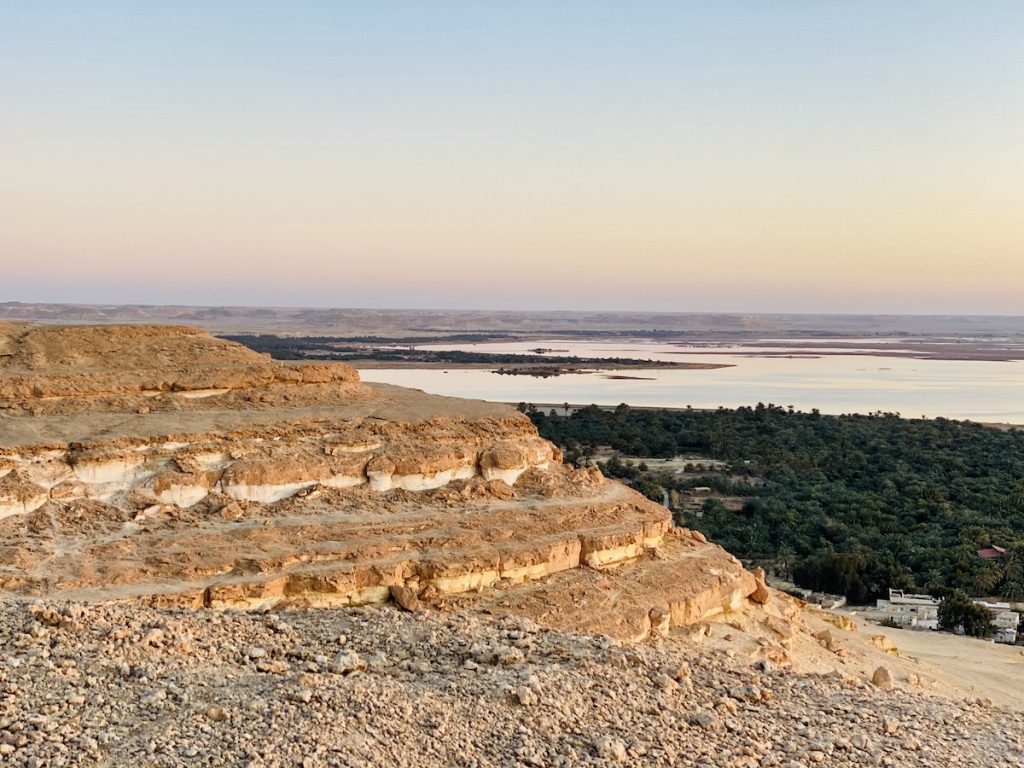
Conclusion
Standing amidst the serene desert landscapes and lush oases of Siwa, it’s easy to understand why this place has captivated travelers for centuries. From the mystical Temple of the Oracle of Amun to the tranquil waters of Cleopatra’s Spring, each landmark tells a story of a rich and vibrant past. The ancient ruins, natural wonders, and timeless traditions of Siwa offer a unique window into a world where history and culture are deeply intertwined. Plan your visit with our Siwa Oasis Adventure Tour and Great Pharaohs and White Desert Tour.
We’ve journeyed through the ancient and spiritual heart of Siwa at the Temple of the Oracle of Amun, explored the resilient and storied walls of Shali Fortress, and wandered among the tombs of the Mountain of the Dead. We’ve soaked in the refreshing waters of Cleopatra’s Spring, uncovered the celestial alignments of the Temple of Umm Ubayd, and basked in the natural beauty of Fatnas Island. We have also marveled at the historical significance of Juba’s Spring, felt the awe of the Great Sand Sea’s vastness, and embraced the cultural richness of Dakrour Mountain.
Each of these landmarks offers a unique glimpse into the history and culture of Siwa Oasis, inviting you to experience the stories that have shaped this remarkable place. Whether you’re drawn by the allure of ancient ruins, the tranquility of natural springs, or the adventure of exploring vast deserts, Siwa has something to offer every traveler.
So, pack your bags and embark on a journey to Siwa Oasis, where the past and present come together in a harmonious blend of history, culture, and natural beauty. Let the ancient whispers guide you through the sands, and discover the timeless wonders of Siwa for yourself. This oasis is not just a destination; it’s an experience that will stay with you long after you’ve left its enchanting embrace.

